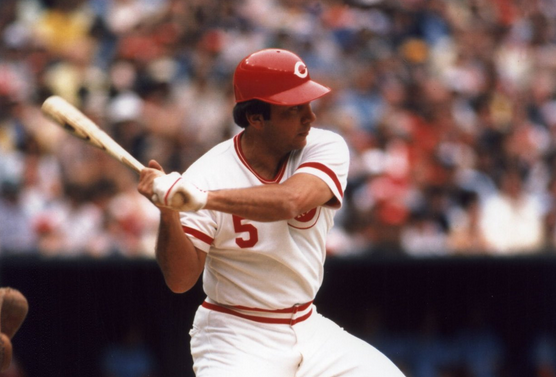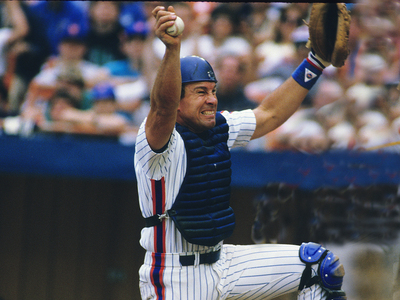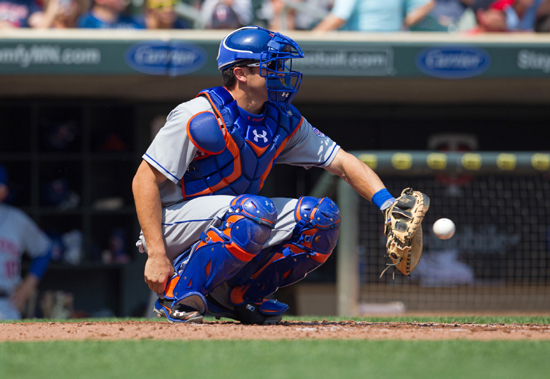
Scarcity: the state of being scarce or in short supply. Scarcity is when you don’t have enough of something you really need, like clean socks and pomegranates – there never seem to be enough pomegranates around when you need them. Pomegranates are a damned delicious fruit … especially if you don’t mind seeds stuck in your teeth.
Anyway, if you are like me and you have just won your MMO Fantasy Baseball League (obligatory fist-pump), you are all about scarcity. There are lots of ways to get production from the outfield — productive outfielders are like the apples of the baseball world. If you shake a stick at a baseball tree a .900 OPS outfielder falls out. Guys like J.D. Martinez and Steve Pearce put out top-tier production for extended stretches at a bargain rate in 2014 and there always seem to be a bunch of hot hitting outfielders that come up late in the season. No, if you want to separate yourself from the competition you’ve got to get production from positions not typically known for offense, you need to find that rare scrumptious Saskatoon blueberry!
Catcher, shortstop, second base and center Field.
When Sandy Alderson and his brainy triumvirate undertook a Mets rebuilding phase in 2010, one of the critical areas they looked at was catcher. They held to the notion that elite catchers in baseball are like great drummers in the rock world – you can’t have a super-group without a great drummer — and you can’t have a playoff team without an outstanding backstop. When you look across the league at the distribution of elite catchers over the past 20 seasons, they seem to appear with inordinate frequency on playoff teams. From Joe Mauer, to Buster Posey, to Yadier Molina, to Victor Martinez, and (more recently) Salvador Perez, an argument can be made that perhaps more than any other position, securing an elite catcher may have the biggest impact on a team’s fortunes.
Now if you want to set the bar high, look no further than Johnny Bench. The Reds’ hall of Fame catcher was like the John Bonham of catchers, no one even came close. Johnny Bench, who was also the backbone of one of the greatest baseball dynasties in the modern era. And it wasn’t just his offense, he was a tremendous presence defensively. You got the feeling that it would be hard NOT to win with a guy like this on your team.

Gary Carter was another example of a player who seemed to direct his teams to the win column by sheer force of will … but an odd thing happens when you look at their production, particularly in terms of WAR. Gary Carter, and Johnny Bench for that matter, don’t rank as high as you’d think. Per Dave Fleming of Bill James Online, Bench’s 5.6/162 WAR ranks most closely with guys like Dick Allen, Larry Walker, and Scott Rolen … All good players but not the earth-shakers in whose elite company you’d expect to see someone like Bench.
And what about Gary Carter? A guy who dominated his position and whose unbelievably positive influence propelled the Mets over the top and right into the history books. He averaged 5.9 WAR from 1977 to 1987, which is certainly good, but it isn’t “elite” good when you look across positions. Carter did have three elite type seasons from 1982 to 1984 where he averaged 7.4 WAR, but when you look at his numbers it does appear that he was already in decline by the time he got to the Mets. What we know of The Kid bears this out – he was famously banged up in 86 but he iced and ace-bandaged himself onto the field and willed his team to victory night after night. His influence on the field remains impossible to quantify; he simply did not allow the Mets to lose. The fact that his decline also coincided with several close-but-not-quite seasons after 1986 should not go unnoticed. The Mets were not quite the same without Gary Carter at the top of his game.
WAR is clearly flawed when it comes to elite catchers. It fails to accurately measure the effect of Gary Carter’s incessant positive coaxing directed at his pitchers, his fearsome competitiveness, his unbelievable energy and interminable tenacity. The fact that It took six years for the BBWAA to vote Gary Carter into the Hall of Fame may unfortunately speak to this numbers bias. Personally I don’t know of anyone who watched Gary Carter play in the early 80’s who wouldn’t consider him a first ballot Hall of Famer. Mike Piazza, another elite Met catcher, has yet to be elected in spite of his career 5.4/162 WAR and gaudy power numbers (or, sadly, perhaps because of them).
The problem with WAR, as Fleming pointed out, becomes apparent not when comparing catchers to catchers, but when comparing catchers to other position players. It’s just not a fair comparison, it’s like saying grapefruits are better than pears because they keep longer and don’t bruise … Catchers have, by far, the most bruising job on the field not to mention the shortest average career span (around five and a half years), A catcher’s production should be looked at through the lens of that hardship if you will — it is precious in a sense because it comes from such a uniquely challenging and unlikely source.
The take away? Elite catchers can improve your team’s chances in a big way, but their performance continues to be maddeningly difficult to assess, with particular caution against comparing production from the catcher’s position to that of other positions. Larry Walker and Scott Rolen were good players, but I would never in a million years put them in the same company as Johnny Bench.

More recently many teams (the Mets and Yankees most prominently) have taken to using extensive statistics on pitch framing. Our very own Travis d’Arnaud, who has been called, among other things, a butcher behind the plate because of his poor throwing and numerous passed balls, nevertheless put together a 1.6 WAR season mostly on the merits of his hitting. Is that accurate? I don’t think so. WAR paints a very narrow picture for catchers, and the absence of pitch framing from these value appraisals is certainly one reason.
Stat Corner ranks TDA as 14th in MLB at the art of pitch framing. The Mets apparently have been meticulously working on improving pitch framing organizationally, (you can read more here) and they appear to have manufactured a good one in d’Arnaud.
Travis has a knack for snatching borderline pitches (especially low balls) back into the strike zone in one fluid twist of the wrist, getting more called strikes on these offerings than just about anyone I can think of in recent memory. Also, among qualified catchers in the second half, d’Arnaud ranks fourth in ISO, tied for fourth in home runs, fifth in wRC+ and sixth in wOBA. Added to his offense and the possibility that his throwing issues were injury related, Travis d’Arnaud may be an elite catcher in the making, if (and that’s a big “if” for any catcher) he can stay on the field.
Between Kevin Plawecki and d’Arnaud the odds are pretty good that we’re going to have decent production from our catchers over the next few seasons. This should, at least in theory, significantly bolster our playoff hopes given the relative scarcity of this type of production. It shouldn’t be lost on us that Gary Carter’s final few elite seasons coincided with a run that bagged us our last world championship.
Met management has done well to fortify our catching ranks with a couple of extremely talented athletes and I very much doubt they will trade either of them … it’s all about supply and demand. Plawecki and d’Arnaud should continue playing for the Mets until two questions can be answered: 1. Can d’Arnaud be counted on to stay on the field? And 2. Will Plawecki’s eye popping numbers translate to the majors? Until then, trading one of two potentially elite difference makers is just too much of a risk.















